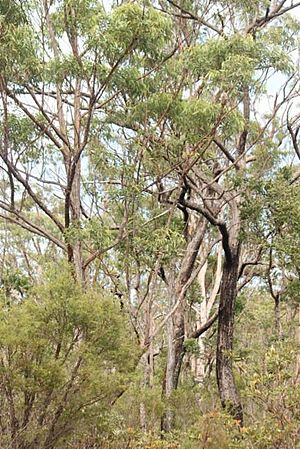Bastard white mahogany facts for kids
Quick facts for kids Bastard white mahogany |
|
|---|---|
 |
|
| Eucalyptus psammitica near Kremnos | |
| Scientific classification | |
| Genus: |
Eucalyptus
|
| Species: |
psammitica
|
Eucalyptus psammitica, commonly known as the bastard white mahogany, is a type of tree. It is a small to medium-sized tree that you can only find in eastern Australia. This tree has rough, stringy, and prickly bark on its trunk and branches. Its leaves are shaped like a spear or are slightly curved. It produces white flowers from groups of seven to eleven flower buds. The fruit of this tree looks like a cup or half a sphere.
Contents
What Does Bastard White Mahogany Look Like?
Eucalyptus psammitica is a tree that usually grows to be about 15 to 20 meters tall. It has a special woody swelling at its base called a lignotuber. This helps it regrow after fires. Its bark is rough, stringy, and loose. It is usually grey or grey-brown on both the trunk and branches.
Leaves and Flowers
Young plants and new shoots have leaves that grow directly from the stem. They are arranged in opposite pairs. These leaves are paler on their underside and are egg-shaped. They can be from 65 to 110 millimeters long and 20 to 50 millimeters wide.
Adult leaves are shiny green on both sides. They are shaped like a spear or are slightly curved. These leaves are typically 70 to 180 millimeters long and 12 to 30 millimeters wide. They narrow down to a leaf stalk, called a petiole, which is 10 to 20 millimeters long.
The flower buds grow in the axils of the leaves. An axil is the angle between a leaf and the stem. These buds appear in groups of seven to eleven. They grow on an unbranched stalk called a peduncle, which is 5 to 18 millimeters long. Each individual bud sits on a smaller stalk called a pedicel, about 3 to 7 millimeters long.
Mature buds are oval-shaped. They are 6 to 7 millimeters long and 3 to 5 millimeters wide. They have a cap, called an operculum, which can be cone-shaped or have a beak-like tip. This tree flowers from October to November, and its flowers are white.
Fruit
After flowering, the tree produces fruit. The fruit is a woody capsule that looks like a cup or half a sphere. It is 7 to 9 millimeters long and 8 to 9 millimeters wide. The parts that open to release the seeds, called valves, are almost level with the rim of the fruit.
How This Tree Got Its Name
Eucalyptus psammitica was first officially described in 1990. Two botanists, Lawrence Alexander Sidney Johnson and Kenneth Hill, gave it its scientific name. They published their description in a science journal called Telopea.
This tree belongs to a group of trees known as the "white mahogany group." Other trees in this group include E. acmenoides and E. carnea. The second part of its scientific name, psammitica, comes from the Greek word psammos. This word means sand, which tells us that this tree likes to grow in sandy places.
Where Bastard White Mahogany Grows
You can find the bastard white mahogany in certain parts of eastern Australia. In New South Wales, it grows from north-west of Coffs Harbour to north-west of Grafton. It is also found in Queensland, specifically south-west of Brisbane. This tree prefers to grow in areas near the coast, especially where there is sandstone. It grows well in shallow, sandy soils.

